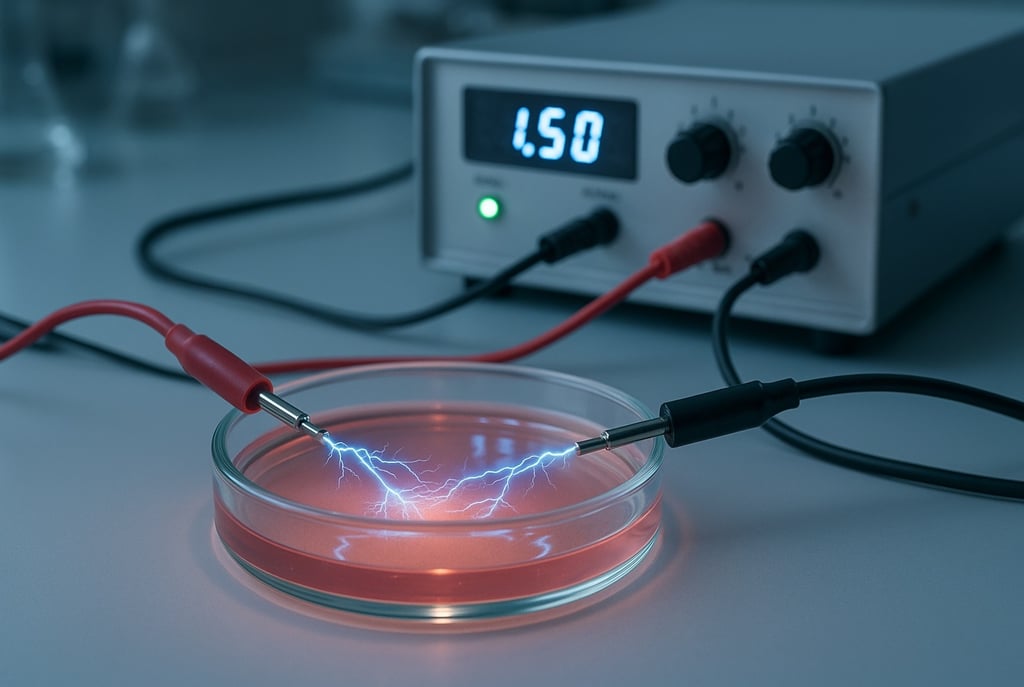Humanity Just Found the On-Switch: Electrically Reprogrammed Immune Cells
A deep dive into the breakthrough Trinity College research showing how human immune cells can be electrically reprogrammed into regenerative mode. This article explores the rise of bioelectronic medicine, the science behind macrophage electromodulation, and why the body’s future may be programmable.
HEALTHSCIENCE AND TECHNOLOGY
11/4/20253 min read


For decades we’ve clung to the cosy illusion that the body is fundamentally chemical, that medicine is chemical, and that every biological crisis can ultimately be bullied into submission with the right molecule in the right dosage. Then a research group quietly took human immune cells, applied a controlled electrical current, and watched those cells change their behaviour like misbehaving staff suddenly informed the regional manager is doing a surprise walk-through. It turns out the body isn’t really a chemical system at all. It’s an electrical one that happens to use chemicals the way a 1970s mainframe used punch cards, because no one’s updated the interface yet.
The Trinity team weren’t exactly subtle about it. They took immune cells, ran a controlled electrical current through them, and watched those cells flip state with the kind of obedience you wish your laptop had when it decides it no longer recognises its own Wi-Fi adapter. Their study showed, plainly, that you can steer macrophages, the immune system’s frontline thugs, from a destructive, inflammatory mode into a calm, repair-oriented one simply by hitting them with a precisely tuned electrical field. This isn’t speculation; it’s measured, validated human data with observable drops in inflammatory markers and increases in pro-repair genes associated with angiogenesis and tissue regeneration, as outlined in this summary and this immunology brief.
And this wasn’t achieved through chemical coaxing, gene editing, or some futuristic nanobot fantasy. It was a matter of shifting the cell’s bioelectric state. Macrophages operate partly on electrical gradients; alter the membrane potential, influence ion-channel behaviour, and the entire phenotype can swing from “burn everything” to “fine, I’ll fix it.” Scientists have been quietly documenting these mechanisms for years, from electrotaxis to voltage-gated channel signalling, as shown in analyses like this ACS Omega review. What Trinity demonstrated is that you can push those levers deliberately, and you can do it with human cells, not just immortalised petri-dish lineages that behave like depressed sea sponges.
The catch, and the opportunity, is that electromodulation only works inside a very narrow therapeutic Goldilocks zone. Too weak and nothing happens. Too strong and you don’t get regeneration; you get inflammation, DAMP signalling, and the sort of immune tantrum you’d expect if you tried to repair a cracked phone screen with a hammer. High-intensity electric fields can drive macrophages into full M1 inflammatory overdrive, as documented in work such as this PubMed-hosted study. Trinity’s success came from engineering their parameters around those known pitfalls. Not accidentally. Deliberately. Like tuning a radio station where moving the dial half a millimetre in either direction replaces music with static and someone shouting in Bulgarian.
But here’s where things become genuinely interesting: once you can electrically steer macrophages, you’re not just improving wound healing. You’re opening the door to a full-blown bioelectronic future. If you can tune immunity, you can theoretically tune inflammation, tissue repair, fibrosis, angiogenesis, maybe even glial behaviour in the brain. Engineers have already begun weaving conductive pathways into biomaterials so that implants can, in effect, “talk” to immune cells, as explored in emerging hydrogel systems like this review and immune-compatible semiconducting polymers shown here. The limiting factor isn’t biology anymore. It’s engineering. How do you deliver a long-term, stable electrical cue without the immune system encasing the implant in a fibrotic tomb like an iPhone buried in sand?
Bioelectronic medicine has been creeping towards inevitability for years. We already use electrical signalling to modulate pain, stimulate nerves, jump-start neurons, and speed up tissue repair. Wound-healing studies, such as this overview, have shown consistent benefit. More recent work demonstrates that DC stimulation alone can shift macrophages into a regenerative mode, as seen in this macrophage polarisation study. But Trinity’s work gives us the unifying principle: electrical control over the key orchestrators of inflammation and repair. Once you can influence that switch, nearly every chronic disease becomes an interface problem, not just a biological one.
Inflammaging? Electrical target.
Autoimmune conditions? Electrical target.
Implant rejection? Electrical target.
Tissue integration? Electrical target.
Age-related immune decline? Also, very likely, electrical.
We’re inching towards a world where implants won’t just sit passively in the body like expensive debris. They’ll monitor, respond, adjust and direct micro-scale biological behaviour in real time, using fine-tuned currents instead of pharmaceuticals with the subtlety of a Molotov cocktail. And once those devices become fully compatible with immune tissue, which is exactly what research into novel conductive hydrogels is trying to achieve, the boundary between “healing” and “upgrading” is going to look less like a line and more like a polite suggestion.
The first real interface between engineered systems and human biology isn’t going to be a neural link shoved into the brain by a billionaire with a flamethrower. It’s going to be a tiny, quiet device telling your macrophages to stop behaving like a medieval torch-bearing mob and start acting like competent repair staff. Today it’s immune cells. Tomorrow it’s multi-cellular regeneration. A decade later, the conversation will be about whether we still count as purely biological organisms or whether we’ve already wandered into the first generation of programmable humans.
Bioelectronic control isn’t coming. It’s already here.
And the moment the body becomes programmable, we all know what happens next.
BurstComms.com
Exploring trends that shape our global future.
Sign up for the regular news burst
info@burstcomms.com
Get the next transmission:
© 2025. All rights reserved.
